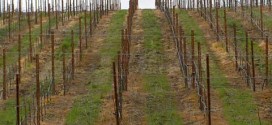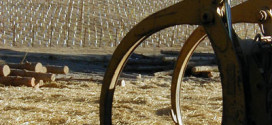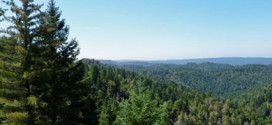“Preservation” Ranch?
Introduction to Scoping Issues
Sonoma County is initiating the Environmental Impact Report (EIR) process for the “Preservation” Ranch proposal, the largest forest-to-vineyard conversion project acre ever proposed in California coastal forestlands.
Comment letters on EIR scope, from:
|
Over 1,600 acres of forest will be converted in a project totaling 19,000 acres in size. The core components of the proposal for County action are permanent rezoning from timber production to rural residential development, granting use permits for 17 ridgetop vineyard blocks, and “consideration” of other project activities. Forest conversion to vineyards is prohibited under current zoning.
The Initial Study describes a project that includes a 3 to 5 year construction period for ridgetop vineyards, reservoirs, gravel quarries, internal road expansion and upgrades, drainage and water delivery systems, worker housing and renewed timber operations. Unlike past versions of the project, this one does not include over one hundred vineyard estate luxury homes (nor does in prohibit their subsequent proposal after permits are issued).
The draft EIR has not yet been initiated. The scoping process is supposed to help shape the content of the EIR – in this case, by reflecting preliminary comments on the Initial Study.
The “Initial Study” in this case is preliminary to the EIR, not a draft EIR. CEQA Initial Studies are a type of preliminary environmental assessment: they are supposed to be brief and succinct tools for sorting out and highlighting raising significant impact issues to address in the EIR.
The Initial Study for this project, however, is over TWO HUNDRED PAGES LONG and approaches the size of an EIR — loaded up with large volumes of background material and details that obscure critically important issues, but without focusing on important alternatives or cumulative and indirect impacts.
The project background study documents are numerous and massive, overwhelming to the general public reviewer and technical reviewers alike. The project description itself has been unstable over years, changing even after the permit application was accepted by Sonoma County.
The massive size and instability of the project documents makes critical review of the project difficult. Environmental issues that scream out for public scrutiny are muffled by the mass of documentation.
To aid public review, Friends of the Gualala River (FoGR) is providing excerpted highlights, or “tabs,” of important items in the Initial Study that could otherwise be buried and obscured. These tabs are taken straight from the Initial Study with page references or verbatim quotations — not our interpretations.
FoGR’s own independent critical questions about the project – an important foundation for scoping – are an open and growing list, expanding as we consult with experts and non-technical residents alike. Our updated question and concern list is presented separate from the Initial Study tabs.
“Preservation” Ranch?
INITIAL STUDY TABS
PROJECT CONSTRUCTION WINDOW (Initial Study p. 2-52). THREE TO FIVE YEARS (PROPOSED)
WORKFORCE AND PUBLIC ROAD USE (Initial Study p. 2-28, 2-36). Seasonal variability of 90 to 215 seasonal workers; “majority of seasonal workers are expected to be transported from Santa Rosa and Windsor/Healdsburg areas in private vehicles provided by farm labor contractors”; no proposed improvements of Kelly Road; with Skaggs Springs Road proposed as the primary access. Project “may include” (p. 2-28) “bunkhouses” for up to 215 seasonal workers.
HOUSING TO BE CONSTRUCTED for approximately 40 full time workers employing bunk houses and separate housing structures. Additional worker housing for 215 seasonal workers to be constructed (pg. 2-28)
NO ALTERNATIVES IDENTIFIED (Initial Study p. 1-7). The initial study is deferring all discussion of alternatives that may lessen environmental impact, and focuses exclusively on the proposed project and mitigation.
PROJECT MODIFIED AFTER SUBMITTAL (Initial Study p. 2-1). The unstable project description has been modified even after the applicant submitted the application. The Initial Study supersedes the April 2008 project description.
HIGHLY ERODIBLE SOILS (Initial Study p. 2-2). Initial Study concedes that vineyards are located entirely on highly erodible soils. Approximately 558 acres of conversion areas have slopes ranging from 30 to 38% on highly erodible soils (p. 2-12)
SOIL FUMIGATION “NOT PROPOSED”, BUT NOT PROHIBITED (Initial Study p. 2-23). Soil sterilants (extremely toxic pesticides that kill all living things in soil) are “not proposed” but not prohibited to future vineyard operators as a condition of approval. The chemical herbicide Glyphosate (e.g. Roundup) will be used for under-vine application on the 1,671 acres of vineyards and on “difficult to access areas.” (p. 3-27)
OVER 10 MILES OF SEASONAL CREEKS FILLED (Initial Study p. 2-24). Approximately 363 Class III stream segments (total length 10.53 miles) would be filled and graded in proposed conversion sites.
OVER 85 MILES OF 8 FOOT HIGH WILDLIFE FENCING would be installed to encircle the propsed vineyards.
40 NEW RESERVOIRS CONSTRUCTED, EACH 10 TO 40 ACRE-FEET CAPACITY (Initial Study p. 2-24). Project would build approximately 40 new 10- to 49-acre-foot reservoirs within or adjacent to the proposed vineyards. All dams will be sized to be under limit that would trigger more vigorous inspection by California Department of Water Resources, Division of Safety of Dams (DSOD) requirements.
GRAVEL QUARRY MINING ON-SITE AND GRAVEL TRUCKING FROM OFF-SITE (Initial Study pp. 2-37 – 2-38). At least 5 upland gravel quarries on-site would be developed and sized to fall below threshold at which they would be regulated under state law. Crushing operations would be on-site. The project is not self-sufficient for gravel demand. An “undetermined additional volume” of gravel is needed to supply housing and “other improvements,” and imported trucked-in gravel may be needed. Blasting may be included in gravel mining.
MAJOR ROAD EXPANSION IN FORESTLAND (Initial Study p. 2-34). The main line property access road off Kelly Road through Evans Ridge to the road junction just east of the fire station lookout would be redeveloped as two travel lanes of 18 feet. No sources for the ongoing need for water for dust control have been provided.
VINEYARD BUFFER ZONES ADOPTED FROM FOREST PRACTICE RULES (Initial Study p. 2-23). Seasonal streams that are not filled and graded would be “protected” by buffer zones adopted directly from Watercourse and Lake Protection Zones (WLPZ) of timber harvest plans. These buffers are currently criticized by resource agencies as inadequate to protect salmonid streams.
“Preservation” Ranch?
Biological and hydrological questions
and concerns of FoGR
Potential unmitigable significant impacts
PIECEMEALING RESIDENTIAL DEVELOPMENT: The current version of the project has dropped from the proposal (and environmental review of impacts) the construction of 116 luxury vineyard estate homes, but rezones the area to accommodate their subsequent proposal and authorization when economic conditions are favorable. How will agricultural conversion and infrastructure with rezoning of presently protected forestland influence development pressure?
FIRE IGNITION RISKS due to agricultural and construction operations: How much will the project’s routine operation of gas-fueled engine equipment in construction, agricultural operations, road maintenance, and forest management increase risk of forest fire ignition? Cover crops in 1,800+ acres of vineyards will be mowed. p. 2-26.
EMERGENCY PESTICIDE SPRAYING TARGETS: Incursion of 1,800+ acres of vineyards over 19,000 acre area of now-protected forestland introduces a vast new potential infestation area for glassy-winged sharpshooters and other agricultural insect pest outbreaks that may trigger “emergency” spraying of highly toxic insecticides within watersheds of sensitive salmonid streams.
HABITAT FRAGMENTATION and MANAGEMENT CONFLICTS WITH LARGE MAMMALS: Lion dens are reported from the site, and widely roaming black bear and mountain lions require large home ranges. Vineyards would fragment their habitats, impede movement, and create conflicts with large mammals.
INDIRECT AND CUMULATIVE EFFECTS ON WATER QUALITY AND SALMONID RECOVERY: The interactive, cumulative and chronic effects of impoundments (reservoirs), lower summer flows, herbicide surfactant drift, pesticide drift, nutrient loading (fertilizer runoff, soil release of nutrients) from vineyards on salmonid streams are qualitatively different from sedimentation impacts of multi-decade timber harvest cycles.
INADEQUATE RECONNAISSANCE-LEVEL BIOLOGICAL SURVEYS FOR SENSITIVE RESOURCES: Biological surveys were focused only on the footprint of proposed vineyard conversion sites; no comprehensive protocol-level biological surveys were conducted for sensitive species and resources in vast matrix of the project area as a whole. The matrix was subjected only to reconnaissance-level (scouting around) and incomplete, cursory survey efforts for wildlife; no plant surveys were conducted outside of vineyard footprints.
The matrix of the project site outside of vineyard boundaries is proposed for road, reservoir, and quarry construction and operation, as well as resumed timber harvest. This is a fundamentally important biological data gap for analysis of significant indirect and cumulative impacts of vineyards, as well as non-vineyard project components. The adequacy and accuracy of biological surveys appears not to have been reviewed by independent scientific experts.
TRIBUTARY CREEK FLOWS, RESERVOIRS, AND AGRICULTURAL WATER DEMAND FOR IRRIGATION AND FROST PROTECTION:
How will impoundment of creek flows behind reservoirs affect pool and channel-maintaining peak flows, and riparian vegetation?
What will prevent cumulative increase in reservoir size and number after permitting, as water demand grows during predicted future severe droughts?
What would prevent landowners from subsequently adding groundwater wells to supplement limited reservoir supplies through droughts or late-season frosts?
What is the availability of ground water in this water scarce (Zone 4) area? (Wells on site produece 2-4 Gal/min; p. 3-69)
How would reservoir impoundments cumulatively affect groundwater recharge and winter peak (channel-maintaining, dominant) flows, and summer base flows in tributary creeks?
What would prevent new or subsequent agricultural landowners from maximizing water resource exploitation allowed by law?
What would prevent new owners from exploiting unregulated diversion of shallow riparian groundwater that supplies downstream river reaches?
DOMESTIC WATER SUPPLY: The Project proposes to provide the domestic water supply for up to four homes for vineyard supervisors and bunkhouses for full- time (31 workers) and seasonal (28-215 workers) laborers. Water supply for other seasonal workers would be transported to the site.
Additionally, the assessment estimates that potential future demand could include an additional 1.0 afy for each of 61 single-family homes on the individual parcels created under the Project. The total demand was estimated to be 21 afy for the Project (including vineyards and farm worker housing) and 82 afy if residences were developed on all of the parcels created by the Project.(p.3-70) (The RRD zoning will also allow second units and worker housing on each of the parcels.)
“SUSTAINABLE” AGRICULTURE UNENFORCEABLE? The project proposes “sustainable” agricultural practices without defining them, and without identifying regulatory authority of the county of other agencies to keep subsequent vineyard landowners and operators bound to specific agricultural practices, let alone “policing” agricultural practices.
What prevents applicants from baiting with “sustainable” agriculture for permitting, letting subsequent vineyard owners switch to conventional agricultural practices which may entail less financial risk and capital outlay?
INVASIVE SPECIES SPREAD: The project would use imported straw and non-native species seed mixes to stabilize all graded and cultivated soils, and expand miles of active roadsides and cultivated edges in what is now extensive, unfragmented forestlands that are otherwise seldom re-entered. These project features are prime vectors for spread of invasive plants and animals in the rest of the state.
PERMANENT WILDLIFE HAZARDS: Many vineyards place square miles of bird netting over vineyard rows and wire trellising, creating hazards to migratory birds and raptors.
PERMANENT LIGHTING AND NOISE IMPACTS (on residents and wildlife): Vineyard operation after construction includes intensive night lighting and night operation of engine-driven equipment and vehicles during harvest and frost protection. Sound and light transmittal in mountainous terrain is irregular and extensive.
How will light and loud noise affect predation, predator avoidance, wildlife social behavior and residential quality of life in surrounding rural residential areas and forestlands?
ATMOSPHERIC CARBON BALANCE: Agriculture is a significant net emitter of greenhouse gases (net atmospheric carbon source), and recent scientific evidence casts doubt on the efficacy of forest thinning practices to increase carbon sequestration. What independent, qualified scientific expertise has been applied to the dubious carbon mitigation proposal of the project?
JUSTIFICATION AND SCIENTIFIC REVIEW OF MITIGATION: The project proposes to fund stream restoration (including wood-in-stream placement), creation of reserves and parks, as mitigation for biological resource impacts. What is the scientific basis – and independent expert scientific peer-review – that provides the foundation for these proposals?
“Preservation” Ranch?
OTHER POTENTIAL IMPACTS
INFRASTRUCTURE NEEDS AND TAX CONSEQUENCES: State and County tax revenue will have to be tapped to pay for increased infrastructure needs resulting from the project’s permanent and seasonal worker population, vineyard operations, potential residential development, etc.
Additional future residential development on each of the 60+ parcels is not addressed. A short list of these increased needs would include road maintenance, fire protection, law enforcement, schools and busing, permitting and inspection services. The affected departments are presently in crisis trying to supply services for this area of the county as it is. The size of this project and its needs for services will swamp budgets supported by tax dollars and require increased taxes to fill the gap.
WHO PAYS FOR THE FOREST RESTORATION PROPOSED? How would this restoration be assured into perpetuity in a project with multiple owners, even with the single management entity proposed?
WHO WILL FOOT THE BILL FOR THE “WINDY HOLLOW” EASEMENT and the Soda Springs Reserve expansion? Who will maintain and manage the 2,700 acre easement? Will this third party and a signed agreement be in place before approval of the project?
ARE THE WINDY HOLLOW EASEMENT’S COSTS AND ADVANTAGES JUSTIFIED? The 2,700 acre easement will not be accessible from any public road, and public use will most likely be limited to a few docent led trips each year.
IS THE BUSINESS PLAN VIABLE? In the present economic climate, is the business model and demand for high end wine grapes grown in a remote and costly location a viable one? Is the business model based on planting pinot noir one that has been properly researched to see if the new vineyards will have the proper conditions for this varietal? Will there be an economic analysis included in the EIR process? Will this analysis be a part of the project’s Alternatives analysis?
Back to “Preservation” Ranch main page
 Friends of Gualala River Protecting the Gualala River watershed and the species living within it
Friends of Gualala River Protecting the Gualala River watershed and the species living within it


